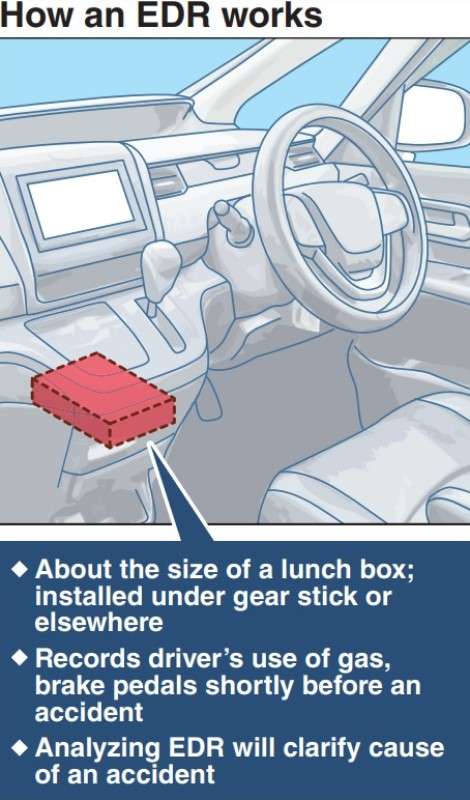
How an EDR works
15:17 JST, July 3, 2021
The transport ministry is planning to require new vehicles to be equipped with an event data recorder, or EDR, a device that records in detail the driver’s use of the gas and brake pedals, The Yomiuri Shimbun has learned.
The relevant provisions of the Road Transport Vehicle Law will be revised as early as this fall. Mandating the installment of an EDR will make it easier to verify whether driver error or vehicle malfunction was the cause of an accident.
The requirement would go into effect from July 2022.
An EDR records how hard and long a driver steps on the gas and the brake. The device can detect less than a second of pressure on a pedal and also notes whether a seatbelt was worn.
Drive recorders, in contrast, keep records through video footage and audio recordings. It is difficult to verify with a drive recorder whether a driver stepped on the gas or brake.
A passenger car went out of control in the Ikebukuro district of Tokyo in April 2019, killing a woman and her child. At the ensuing trial, a major point of contention was whether the driver of the car — a former head of the now-defunct Industrial Science and Technology Agency, under what is now the Economy, Trade and Industry Ministry — was at fault.
EDR records were submitted as evidence.
Although EDRs have been installed in many new cars sold in the last few years, only about half of the cars in Japan are currently equipped with one, according to Bosch, a major German auto parts manufacturer.
Amid a spate of incidents that appear to be caused by drivers mistakenly stepping on the gas, the Land, Infrastructure, Transport and Tourism Ministry has decided that increasing the installment of EDRs by making it compulsory is essential to verify the cause of accidents.
The device itself is about the size of a lunch box and is installed near the gear stick. It can cost tens of thousands of yen if the person who caused an accident wants to retrieve the records for verification.
The transport ministry will also require systems to detect other vehicles and pedestrians, in tandem with the spread of EDRs.
From November, new cars that are to be fully upgraded will have to have a system that can detect cars and pedestrians standing at least 115 centimeters tall, the equivalent of a 6-year-old, during the day and automatically brake the car. The ministry is planning to require that the system be able to detect cars and pedestrians at night as well.
From July 2024, the ministry is also expected to require that such systems be able to detect bicycles during the day.
"Society" POPULAR ARTICLE
-

M4.9 Earthquake Hits Tokyo, Neighboring Prefectures
-

M7.5 Earthquake Hits Northern Japan; Tsunami Waves Observed in Hokkaido, Aomori and Iwate Prefectures
-

Tsukiji Market Urges Tourists to Avoid Visiting in Year-End
-

Israeli Tourists Refused Accommodation at Hotel in Japan’s Nagano Pref., Prompting Protest by Israeli Embassy and Probe by Prefecture
-

M5.7 Earthquake Hits Japan’s Kumamoto Pref., Measuring Upper 5 Intensity, No Tsunami Expected
JN ACCESS RANKING
-

Keidanren Chairman Yoshinobu Tsutsui Visits Kashiwazaki-Kariwa Nuclear Power Plant; Inspects New Emergency Safety System
-

Imports of Rare Earths from China Facing Delays, May Be Caused by Deterioration of Japan-China Relations
-

University of Tokyo Professor Discusses Japanese Economic Security in Interview Ahead of Forum
-

Japan Pulls out of Vietnam Nuclear Project, Complicating Hanoi’s Power Plans
-

Govt Aims to Expand NISA Program Lineup, Abolish Age Restriction






















